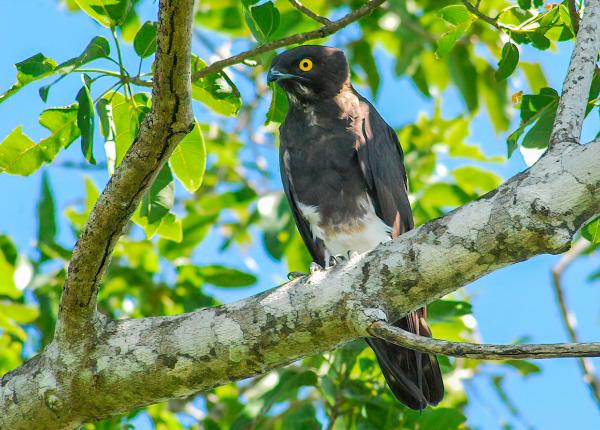Did You Know?
- The Peregrine Fund is working to protect habitat in Madagascar where Bat Hawks can be found.
- Bat Hawks are skilled hunters and may capture and eat a large number of prey items (up to 11 in as little as 18 minutes) during the short period at dusk when bats are emerging from their roosts.
- Unlike the Orange-breasted Falcon, male and female Bat Hawks are not much different in size.
How The Peregrine Fund is Helping
The Peregrine Fund's Madagascar Project is supporting a student who is doing her research on Bat Hawks in Madagascar. This student recently received her Masters degree while focusing on the nesting ecology of Bat Hawks and is currently pursuing her doctorate.
Where They Live
The Bat Hawk has a very limited range. It can be found in Sub-Saharan Africa, Madagascar, and the Malay Peninsula - including the countries of Sumatra, Borneo, and Sulawesi, and in New Guinea.
Depending on where it lives, the Bat Hawk can be found in several different types of habitats. According to researchers, in Africa this striking hawk occurs in open spaces in moist wooded and forest edge habitats. It can often be found close to watered areas and gorges, and has even been documented living in or near cities, villages, and tree plantations - such as those growing eucalyptus. It has not been found in dry areas or in dense forest.
On the Malay Peninsula, it is found in mature and disturbed forest as long as there is still some tall vegetation that remains. In New Guinea, it is found in partly cleared or disturbed forest and gallery forest - which is a forest that runs along a river or wetland before extending into less forested habitats. It is mostly a lowland species, but reaches high plateaus in southern Africa.
This species spends quite a bit of its time in the vicinity of limestone caves frequented by bats and swiflets, or swallows. It is also frequently seen around suburban street lighting. This is because insects are attracted to the lights, and bats are searching for insects to feed on, and Bat Hawks, of course, are fond of feeding on bats.
What They Do
The Bat Hawk is a very pretty, medium-sized hawk that is mostly dark brown or black all over, with the exception of a white patch on its throat and upper breast and its large, bright yellow eyes and pale legs. It also sports a short, black crest.
The Bat Hawk is mostly crepuscular, meaning it is most active at dusk or dawn. During the day, it spends much of its time perched with its eyes closed within the canopy or shade of a tree. It is often undisturbed by the presence of humans or noisy vehicles and can sometimes be seen perched nearby busy roads.
This is not a gregarious species, so it spends most of its time alone or in a pair.
Why They Need our Help
Though widespread, the Bat Hawk is uncommon and hard to detect. As you can imagine, a bird that hunts at dusk or dark and then spends the day roosting in trees with dense foliage would be hard to locate. It follows that birds that are hard to locate are also difficult to study. Despite this, we do know a few things about this hawk.
Though it is categorized as "Least Concern," it still faces many threats. Collisions or electrocutions on power lines may be serious threats for this species. And their nests are vulnerable to destruction by high winds.
What They Eat
As its name suggests, the Bat Hawk feeds primarily on... you guessed it... bats which they capture in flight and swallow whole! But their menu choices aren't limited to just bats. They also predate on insects and birds, including swifts and swallows. Bat Hawks, like most raptors, capture their prey with their feet.
This species hunts mostly at dusk, but also on moonlit nights, at dawn, and occasionally during the daylight hours.
Bat Hawks have to work hard to capture bats during the short period of time that bats are emerging from their roost. Though they have only about a half hour, Bat Hawks can often capture enough prey to satisfy their entire daily requirements.
Nest, Eggs, and Young
Bat Hawks build large stick nests that they place high up in trees. Their nests are usually lined with fine twigs and green leaves. They seem to prefer to place their nests in eucalyptus trees, and they will re-use the same nest year after year.
The female lays one (or rarely two) pale blue-green egg. Though the male helps out, the female does most of the incubation. She sits on her eggs to keep them safe and at a good temperature for around 48 days. After the fluffy chicks hatch, they stay in the nest for another 67 days before they are ready to fly. During this time, both parents work hard to feed their young.
Pairs may attempt to breed more than once per year.
Though you have just read above that these birds are mostly active at dusk and dawn. And this is true for most of the year. However, during breeding season, these birds become more active during daylight hours. At this time, they spend much of their day performing vocal display flights.
Bat Hawk and The World Center for Birds of Prey
The World Center for Birds of Prey offers fun ways to learn about raptors. The visitor center has interactive displays, tours, interesting videos and a children's room with activities from coloring sheets to quizzes to costumes and a touch table for the curious mind. Knowledgeable staff and volunteers are on hand to answer any questions you may have about Bat Hawks or any other bird of prey.
References:
Global Raptor Information Network. 2021. Species account: Bat Hawk Macheiramphus alcinus. Downloaded from http://www.globalraptors.org on 11 Aug. 2021









